Angelfish of the Brazilian coast
Angelfish is the common name given to various protogynous hermaphroditic fishes. This means that if the dominant male of a harem is removed, a female will become a functioning male. They come in a variety of species with a thin, oval body, spiny fins, and a small, protruding mouth. Because of their eye catching colors, they are considered by many to be the most beautiful marine fish and are highly desired by aquarists.
They are found at depths of 2 meters (6.5 ft) and live near coral reefs where the adults feed on algae, tunicates and especially sponges. They therefore play an important role in preventing the overgrowth of reef-building corals.
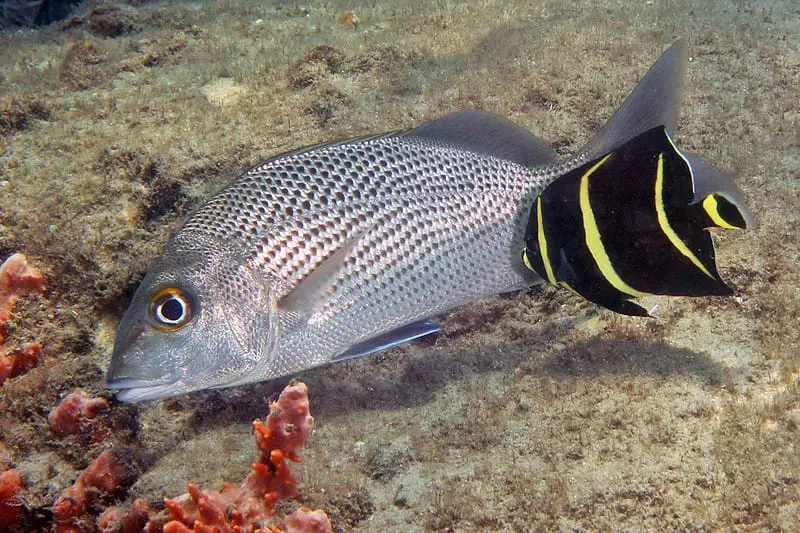
The young, however, feed on small parasites that lodge in the bodies of other fish, maintaining a symbiotic relationship with several larger species. The young French angelfish, for example, wiggle their colorful bodies and attract fish that wish to be cleaned, creating “cleaning stations.” These fish will swim over the area or lie on the bottom and open their mouths and gills to allow the French angelfish to remove slime and parasites from their bodies.
Angelfish belong to the family Pomacanthidae. Although there are 87 species and about 7 genera distributed in the tropical waters of the Atlantic, Indian, and western Pacific Oceans, in Brazilian waters there are only five species belonging to three genera.
Holacanthus ciliaris
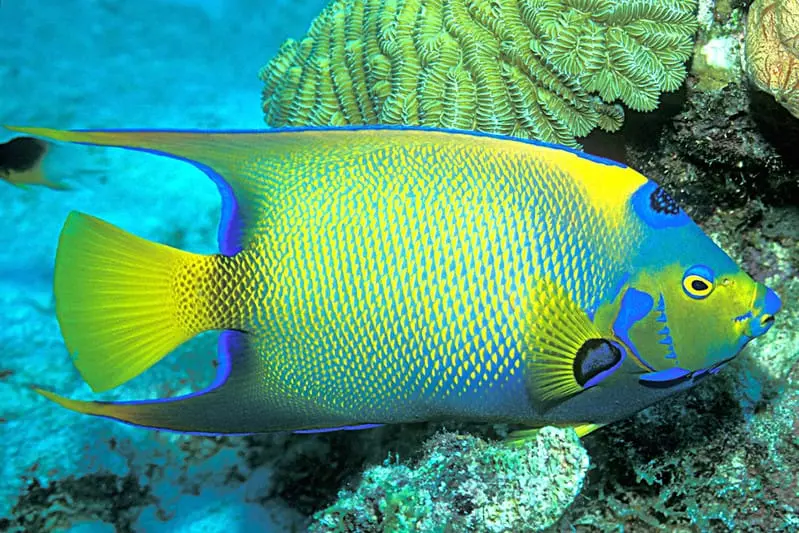
The queen angelfish - as it is popularly known - reaches a maximum length of 45 cm (17.7 in) and weighs up to 1.5 kg (3 lb). It is recognized by its blue and yellow coloration and a patch (or “crown”) on its forehead.
As with most angelfish, its coloration changes with life stage. Fully mature individuals are predominantly yellow, with their anal and dorsal fins outlined in light blue, as are their gills, eyes, and mouth. They also have a black, blue-edged spot on the top of their heads that resembles a crown, giving the fish its popular name.
Juveniles, however, have a dark blue head, body, dorsal and anal fins, and five light blue vertical stripes all over the body. The mouth, chest, and pectoral, ventral, and caudal fins are yellow. However, in the archipelagos of São Pedro and São Paulo in Pernambuco, some specimens with non-standard colors (white or completely blue) have been sighted.
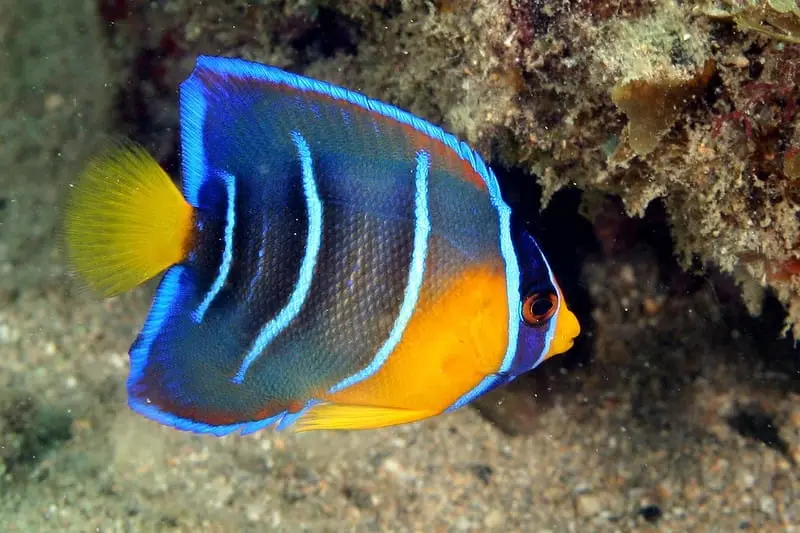
Queen angelfish live in harems of one male and two to four females within a large territory. Little is known about the sexual development of the species, although they are assumed to be protogynous hermaphrodites.
The queen angelfish is popular in the aquarium trade and is widely exported from Brazil. From 1995 to 2000, 43,730 fish were traded in Fortaleza, representing 50% of the total trade. Almost 90% of the fish trade was directed to the international market.
Despite this, it is not an easy species to keep in aquariums and requires a high level of water quality, lighting and feeding to maintain its vibrant colors. If kept improperly, the angelfish will lose its blue colors, turn completely yellow, and die.
Holacanthus tricolor
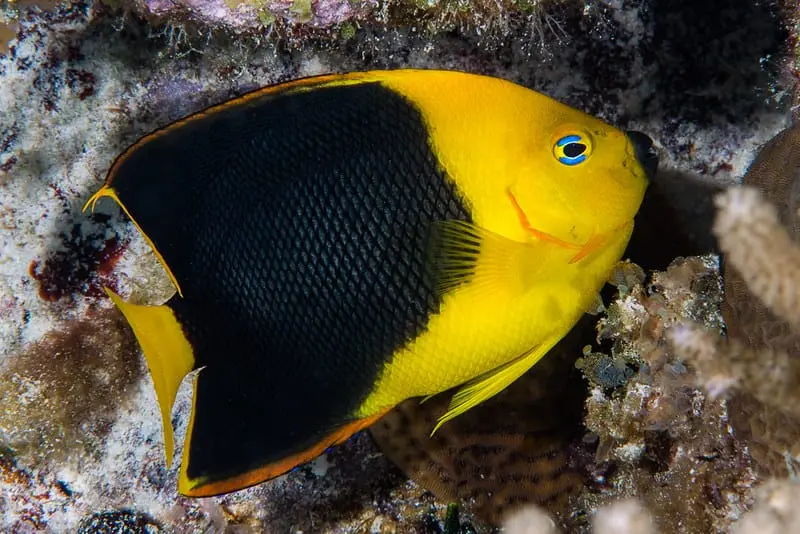
Also known as rock beasty, coshubba, corn sugar, yellow nanny, and catalineta, this is the most common angelfish found in the western Atlantic reefs. It is also the smallest angelfish found off the Brazilian coast (except for the dwarf angelfish) - the males, which are usually larger than the females, measure up to 35 cm (13,7 in) in length.
It is a fish easily distinguished by its colors: the head and front of the body is yellow, the back is black, and the edges of the dorsal and anal fins are orange-red. The mouth also becomes black during the breeding season. Juveniles are yellow with a small “false eye” (a black spot with a blue border) on the side of the body to confuse predators. As the fish mature, the black becomes larger and the blue outline disappears.
The Rock Beauty is usually very territorial and shy, spending most of the day in hiding. As such, its dark coloration helps it hide and escape from predators.
Although difficult to keep, it can be bred in the aquarium. It must be fed a special diet and requires very large tanks with carefully selected fish to avoid conflicts.
Pomacanthus paru
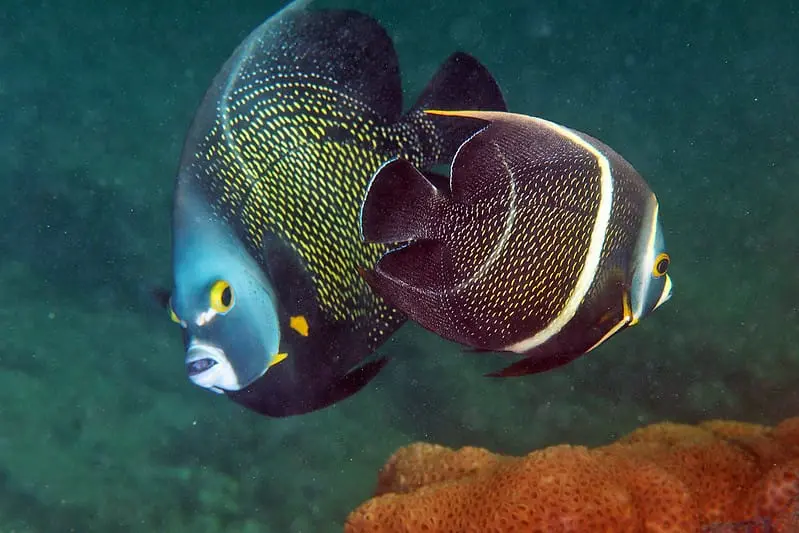
The body of the French angelfish is black with yellow scale tips (except on the chest and fins), the base of the pectoral fins are yellow, as are the eyes. Juveniles have a completely different coloration: they are black with five vertical yellow stripes all over the body, and blue tips on the pelvic and anal fins.
The French angelfish is one of the largest reef fishes, preyed upon only by groupers and large sharks. The largest specimen ever recorded was 61 cm (24 inches), but they usually measure around 40 cm (15 inches). In the wild, the French angelfish is widespread and can be found from Florida to north of Rio Grande do Sul.
It is a very territorial fish and will chase away all that approach its territory. They are monogamous and will stay with their mate until death, but unlike other angelfish, females cannot change sex in the absence of males.
French Angelfish also differ from other angelfish in their high tolerance to environmental changes, disease resistance, and longevity, making this species ideal for aquariums.
Pomacanthus arcuatus
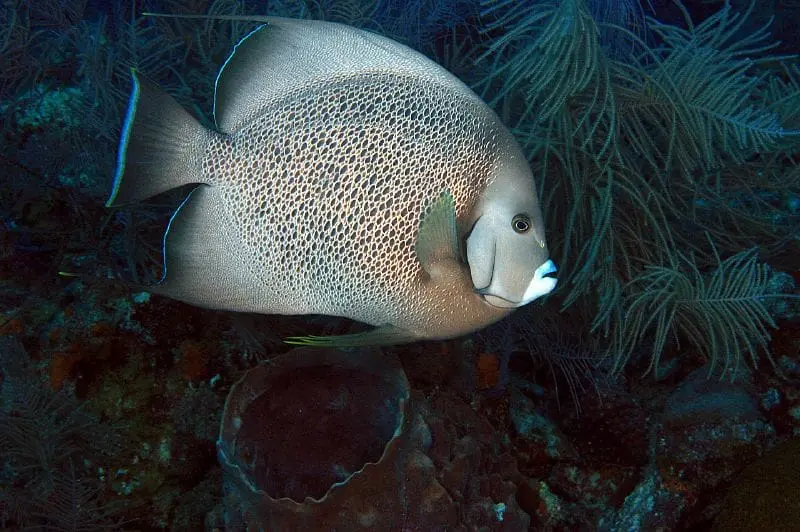
The Gray angelfish usually measure up to 45 cm (18 inches), but specimens as large as 60 cm (20 inches) have been found. Its scales are mostly gray with black spots; its mouth is white; the pectoral fins are yellow and the scales have a white outline. The head is gray-blue.
Juveniles are very similar to juvenile French angelfish: black with five yellow stripes all over the body and blue tips on the pelvic and anal fins. As they mature, they change to a uniform gray and their rounded fins become more pointed over time.
Because there is a close relationship between the two, we call them “sister species”. This means that both species descended from a single common ancestor that split apart over the years. There are some minor differences between the Gray Angelfish and the French Angelfish:
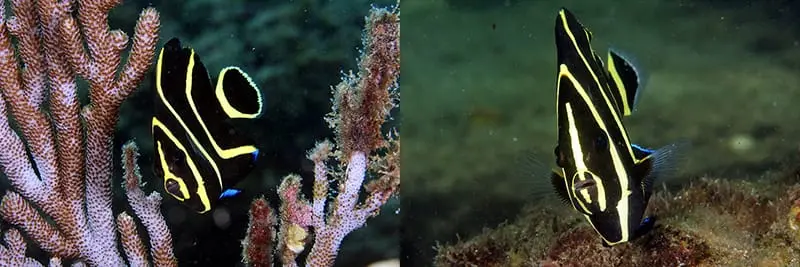
French angelfish have a noticeable yellow line at the end of the tail, which is absent in young Gray Angelfish. Gray angelfish, on the other hand, have a small line below the lower lip (like a small goatee), which French angelfish do not have.
Unlike the angelfish of the genus Holacanthus, those of the genus Pomacanthus are monogamous and are most often seen swimming as a pair. Gray angelfish have a large geographical presence, being distributed from Florida to Rio de Janeiro, with stable populations. In Brazil, it has been established that 3,000 specimens can be captured and sold to aquarists annually. Between 1995 and 2000, more than 12,000 Gray Angelfish were exported from Brazil.
Centropyge aurantonotus
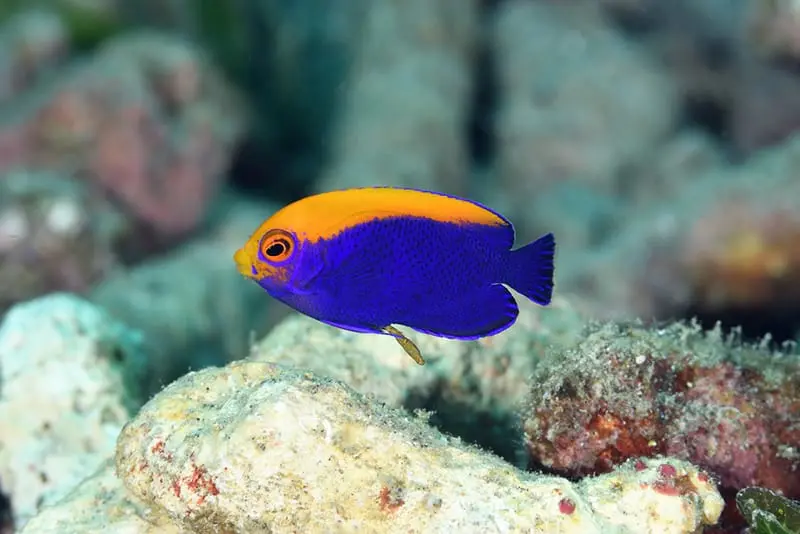
Also known as Brazilian flameback angelfish, flameback pygmy angelfish, fireball angelfish, or Caribbean flameback. Its body is predominantly blue with a yellow stripe across the face, back and almost the entire dorsal fin. The coloration of juveniles is the same as that of adults, the only difference being the yellow on the top, which extends to the end of the dorsal fin.
This is the smallest angelfish species, reaching a maximum of 7.5 cm (3 in) in length. It is often confused with the Centropyge acanthops of the Indian Ocean, but differs in that it is yellowish rather than reddish. Of the 37 species of the genus Centropyge, only C. aurantonotus is found in Brazil, occurring from Venezuela to São Paulo.
The flameback angelfish has a long life span in its natural habitat and is very adaptable to aquarium life - living to over eight years. It is also one of the few angelfish species considered safe for corals.
Brazil is a major exporter of freshwater ornamental fish and a major supplier of marine species. Despite the growing demand for tropical marine fish, control and registration of the trade is inconsistent and almost non-existent. Similarly, the conservation measures and catch quotas established by Ibama are ineffective due to the lack of a database.
Although Fortaleza is one of the main centers of the marine ornamental fish trade, very little is known about the species caught, such as their population status and collection areas. To date, however, none of the species mentioned here are on the International Union for Conservation of Nature’s list of threatened fish.
Read more at:
French angelfish - Florida Museum
The Online Guide to the Animals of Trinidad and Tobago - Pomacanthus paru (French Angelfish)
What a Darling Little Angel: The Genus Centropyge
Monteiro-Neto, Cassiano & Cunha, Francisca & Nottingham, Mara & Araújo, Maria & Rosa, Ierecê & Barros, Glaura. (2003). Analysis of the marine ornamental fish trade at Ceará State, northeast Brazil. Biodiversity and Conservation. 12. 1287-1295. 10.1023/A:1023096023733.
